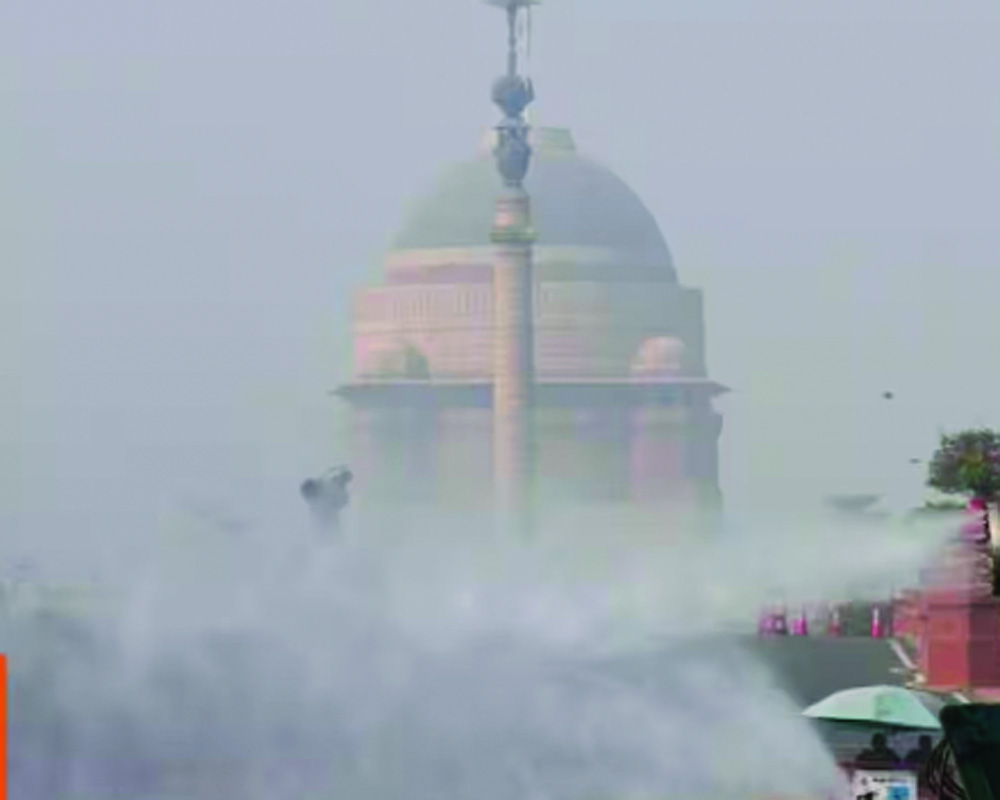Despite court orders, government promises, and short-term measures like vehicle restrictions and artificial rain, Delhi’s air quality remains perilously poor
Why do the residents of Delhi experience pollution every year while the ruling class blames it on stubble burning in the neighbouring states of Haryana, Punjab, and Uttar Pradesh? Can't they find a permanent solution instead of debating who will pay for the burning machines and other related expenses?
The air pollution levels in Delhi are eight times higher than the WHO's prescribed limits. It has reached a level where the judiciary, executive, and parliament blame each other, and the severe pollution level continues. Returning from a month-long holiday in the US, I was immediately struck by the urgency of the pollution crisis as I landed in Delhi, past midnight this week.
The dark skies, sheets of dust, heat, and difficulty in breathing welcomed me as a stark reminder and a pressing call to action. The pollution levels in Delhi have soared to their highest this week. It has reached hazardous levels, causing state officials to limit movement and revive plans to stimulate artificial rain to clear toxins. This forced the schools and offices to close due to cloaking the city in thick brown smog and demanded immediate action.
The number of respiratory diseases in children and older adults is rising, along with other health issues. In cold winters in the north, smog covers the area every year and traps harmful pollutants from fires, construction, and factories. This issue worsens when farmers burn their fields after harvesting rice to prepare for new crops. The same or even worse scenario unfolds yearly, reaching alarming levels over time. Citizens feel helpless while politicians engage in a blame game. As a result, the public endures poor air quality, which seriously threatens their health. Affluent individuals often escape to warmer destinations during winter, but children and older people suffer the most. Many schools have closed, and residents have been advised to stay indoors. Construction work has been halted, and the government is considering implementing an odd-even vehicle use policy to control pollution. While this is a step in the right direction, the severity of the crisis requires effective solutions without further delays.
According to the Central Pollution Control Board, the World Health Organization, and other monitoring agencies, Delhi's air quality index (AQI) ranges between 1,200 and 1,500. India's AQI is classified as poor when it exceeds 200, very poor when it exceeds 300, and severe or hazardous when it exceeds 400. The recommended AQI limit is between 0 and 100. This alarming situation discourages international travellers and members of the Indian diaspora from planning their annual visits.
The government and politicians are well aware of the root cause of the problem but play the blame game. The Supreme Court has ordered the government to address pollution.
In the past, it has even led efforts to improve air quality in Delhi. It has set rules about which vehicles can operate in the city, ordered the relocation of many factories that pollute the air, and closed businesses to reduce emissions. The court also pushed the government to take action. The fault lies in the implementation. Last month, the Supreme Court ruled that clean air is a fundamental human right. It ordered both the central government and state authorities to take immediate action. However, most measures, such as vehicle restrictions, industrial regulations, and public awareness campaigns, must be more effective in preventing deteriorating air quality. Critics question how effective the court's decisions are and accuse the judiciary of interfering in executive matters.
In its 2024 manifesto, the Aam Aadmi Party (AAP) government in Delhi did not include promises to reduce pollution, unlike previous ones. Instead, the manifesto focused on the National Clean Air Programme (NCAP) and ways to cut pollution. APP highlighted the need for citizen involvement and plans to use electric buses to control pollution.
Now that it has reached an alarming stage, the Centre and the state governments must take a balanced approach concerning Punjab, Haryana, and Uttar Pradesh, which are the real culprits. Every winter, smoke from farm fires engulfs Delhi and covers the Delhi skies. Farmers resort to burning as it is the cheapest method of clearing their fields.
The state governments demand that the Centre provide funds to assist farmers in reducing smoke emissions, but the issue persists yearly. Meanwhile, politics also plays its role. The BJP governs the Centre, while AAP rules Delhi and Punjab. The Congress remains an onlooker. This attitude does not help implement an effective plan.
The experts say it's high time half-measures were shunned, and comprehensive solutions are implemented. For instance, GRAP-III must be upgraded to GRAP-IV, facilitating the enforcement of the odd-even rule. The election to the Delhi Assembly is around the corner. People must make it an election issue. In the meantime, residents of Delhi should consider quick solutions to combat pollution, such as wearing masks, indoor air-purifying plants, and the affluent using air purifiers, taking steam baths, eating healthy foods, and ensuring proper ventilation in their homes. The citizens must also assist authorities in any efforts to help control pollution.
(The writer is a popular columnist; views expressed are personal)


























